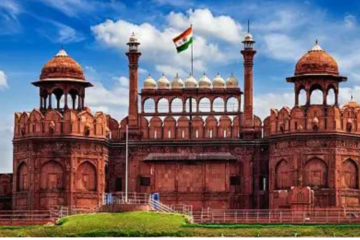
The Agra Fort, sometimes referred to as Agra’s Red Fort, is a medieval fort in the city of Agra. At this fort, Mughal emperor Humayun was crowned. It was later reconstructed beginning in 1565 by the Mughal emperor Akbar, and the current building was finished in 1573. Up until 1638, when Agra was replaced by Delhi as the capital, it served as the Mughal dynasty’s primary home. The “Lal-Qila” or the “Qila-i-Akbari” were other names for it.The Marathas were the last Indian kings to control it before being taken by the British. Due to the Agra fort’s significance during the Mughal dynasty, it was listed as a UNESCO World Heritage Site in 1983. It is located around 2.5 kilometers (1.6 miles) northwest of the Taj Mahal, its more well-known sibling structure. A walled city would be a better way to define the fort. Shah Jahan later restored it.
Like the rest of Agra, the history of Agra Fort prior to Mahmud of Ghazni’s invasion is unclear. However, the Chauhan Rajputs took control of it in the 15th century. Sikandar Khan Lodi (1487–1517 CE), who relocated his headquarters from Delhi to Agra and added a few structures to the fort that already existed there, gave the city of Agra its position as the nation’s capital not long after. Mughals seized control of the fort after the first Battle of Panipat (1526 CE) and governed from there. Humayun was crowned there in 1530 CE. During the reign of Akbar (1556–1605), the fort received its current look. Later, the Jats of Bharatpur ruled over this fort for 13 years.

History:
Babur resided at the fort, in Ibrahim Lodi’s palace, following the First Battle of Panipat in 1526. Later, he turned it into a baoli (step well). In 1530, the fort hosted the coronation of his successor, Humayun. Sher Shah Suri beat him at Bilgram in 1540. The Suris held the fort until 1555, when Humayun retook control of it. Hemu, a commander of Adil Shah Suri, conquered Agra in 1556 and followed the city’s emancipated ruler to Delhi, where they clashed with the Mughals in the Battle of Tughlaqabad.
Akbar established Agra as his capital in 1558 after realizing the value of its strategic location. This brick fort was called “Badalgarh,” according to his historian Abul Fazl. It was in ruins, therefore Akbar ordered that it be reconstructed using red sandstone from the Rajasthani region of Dhaulpur in the Barauli area. The structure’s foundation was set by architects, and it was made with bricks for the interior core and sandstone for the exterior surfaces. It took eight years and 4,000 workers daily to complete in 1573.
The site did not take on its present form until Shah Jahan, the reign of Akbar’s grandson. In honor of his late wife Mumtaz Mahal, Shah Jahan constructed the Taj Mahal. Shah Jahan, unlike his grandfather, favored having white marble used in construction. Shah Jahan was imprisoned in the same fort in 1658 after Aurangzeb defeated all of his brothers.
For 13 years, the fort was ruled by the Jats of Bharatpur. They constructed the Ratan Singh ki Haveli inside
the fort. Early in the 18th century, the Maratha Empire attacked and took control of the fort. After thereafter, it often passed between the Marathas and their enemies. Marathas withdrew from the area for the following ten years after Ahmad Shah Abdali’s devastating victory in the Third Battle of Panipat in 1761. In 1785, Mahadji Shinde finally captured the fort. During the Second Anglo-Maratha War in 1803, the British won it from the Marathas.Battles fought there during the Indian uprising of 1857 led to the dissolution of the British East India Company and the establishment of British direct authority over India for a century.
36 persons lost their lives when a cartridge factory inside the fort burst on November 30, 1871.



